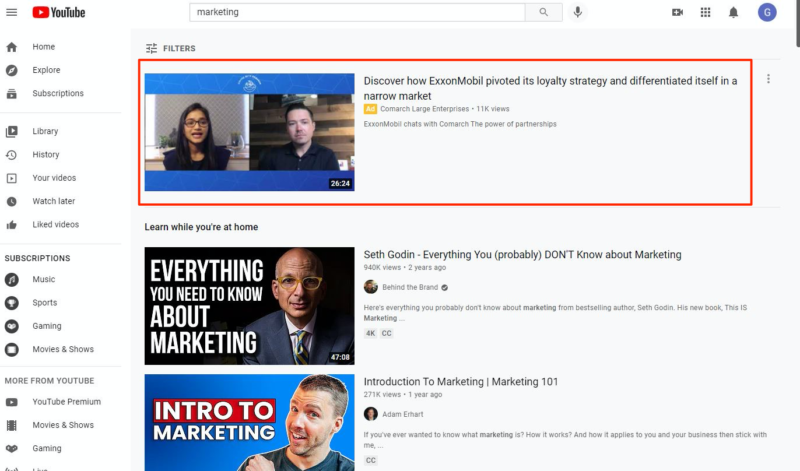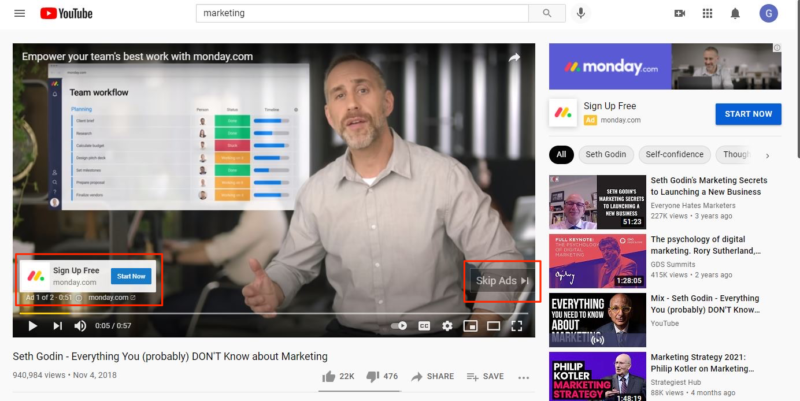Video marketing opens an opportunity for marketers to present engaging advertisements to a receptive audience. Video has been proven to be a highly effective form of marketing, with many studies reporting up to 49% faster revenue growth in businesses that use video marketing.
As the penetration of video content grows, we see increased interest from our clients large and small and across a wide range of verticals. With that in mind, we wanted to focus today on the 800 Lb gorilla of the video world, YouTube.
YouTube offers a place for advertisers to display short video advertisements to a large audience of viewers. Explore details on the platform and its advertising options below.
Who Uses YouTube?
YouTube launched in 2005, and it’s user base has grown steadily ever since. As videos on the platform began to see virality, the opportunity for monetization began. Today, 77% of people aged 15-25 are using YouTube as a form of entertainment and as of 2020, users collectively watch almost 5 billion YouTube videos per day.
Like many new technologies, in its infancy, YouTube was a platform frequented mainly by teens and young adults, however this is no longer the case. Today, 73% of adults report using YouTube regularly, and users between the ages of 35 and 55 are the site’s fastest growing demographic. It has become such a popular form of entertainment that YouTube now stands as the second most visited website behind Google.
Why YouTube is Important for Marketers
With such a wide demographic of users, YouTube offers a great way to reach almost any imaginable audience. Video ads can be as simple as a clip shot on your smartphone, to complex, professionally produced pieces. The ads themselves are easy to set up, as they’re curated and controlled through Google Ads, allowing them to integrate seamlessly with your Google advertising plan and budget.
With over 2.3 billion people accessing YouTube at least once a month, there’s never been a better time to invest in YouTube ads.
Types of YouTube Ads
Video Discovery YouTube ads show up on the YouTube homepage, search results pages, and on YouTube video watch pages as related videos. These ads most often appear after performing a YouTube search.

TrueView in-stream ads play before, in the middle, and after the main video. These ads can be any length, and may also give the viewer the option to skip the ad after the first five seconds. YouTube recommends that, for best results, in-stream ads should be kept below 3 minutes in length.

Some in-stream ads are non-skippable. The option to make your YouTube ad non-skippable is found within the settings of your Google Ads campaign. Non-skippable ads must be between 6 and 15 seconds in duration. TrueView ads can also be played anywhere within the Google Display Network (GDN) on sites that purchase Google video ad space.
Finally, a style of YouTube advertising that is growing in popularity is integrated sponsorships. Video sponsorships occur when a business directly contacts a YouTube creator to request that they promote the business’ goods or services within one or several videos, in exchange for compensation. In integrated video sponsorships, the YouTube creator generally discloses the name of the business that is sponsoring the video, and then reads the agreed upon script, which can be anywhere from a few seconds to several minutes in length. This style of YouTube ad is not moderated by Google Ads, so it can be challenging to make the necessary personal connections, and prices can vary greatly from creator to creator.
If you’re interested in a customized performance marketing plan, reach out to us. To stay connected to the latest news in marketing and to see all of DSG’s latest blogs, be sure to follow us on social media.


